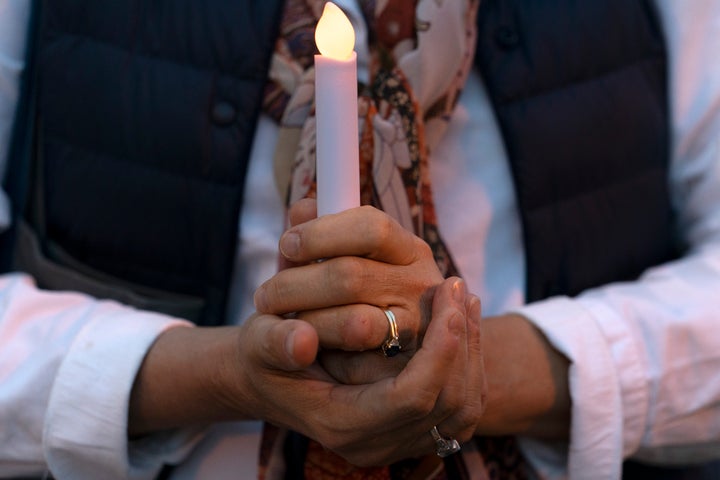We need a national day of mourning for the coronavirus.
As the first vaccinations began in the U.S. on Monday, bringing with them a ray of hope, the nation hit a grim milestone: more than 300,000 people dead from the virus so far.
“We’ve been struggling,” said Douglas Yankton, chairman of the Spirit Lake Tribe in North Dakota. Native Americans have been disproportionately infected, hospitalized and killed by the virus. Yankton lost four family members — an uncle and three cousins — in the span of a week.
“It’s a burden not only on the families but on the community when we keep having to bury our people,” he said.
Scott Davis, a member of the Standing Rock Sioux Tribe, who lost two cousins and a friend to COVID-19, said that there’s been “no closure” as coronavirus protocols have prevented people from visiting hospitalized loved ones or gathering for funerals.
“They go to the hospital, you can’t see them, you can’t be around them, and all of a sudden it happens, and then the families are left struggling to have closure,” he said. “You gotta mourn.”
With an average now of 2,400 people dying each day of the coronavirus, Black and Latinx people have also been disproportionately affected — not only by the deaths but also by the economic fallout from the pandemic, including high rates of joblessness.
Grief coach Breeshia Wade said that a national day of observance for the coronavirus losses would be important for “accountability and acknowledging the massive failure in how this played out.”
“It’s not just the death toll. There’s the loss of a way of life, of American identity and what it means to be a cohesive country that comes together to protect its citizens,” Wade said. “There’s a loss of trust with our neighbors, with some wearing a mask and some who aren’t.”
“We need something to bring us together to honor what has been lost if we’re going to have any hope of healing,” she added.

National days of observance are typically enacted by Congress, after which the president issues a proclamation on that day each year and local governments may also hold dedicated ceremonies or events. Existing ones include Veterans Day and Hispanic Heritage Month.
Rep. Donald Payne Jr. (D-N.J.) introduced a resolution in the House last month calling for a day of mourning for coronavirus victims in January, to provide “a national opportunity to grieve.”
The legislation, which specifically calls out the disproportionate infection rates and deaths among communities of color, is sitting in the House Oversight Committee. Payne, whose best friend lost his mother to COVID-19, plans to ask other lawmakers to support the resolution once the more immediate concern of passing another economic stimulus package has been resolved.
“Every elected official in Washington has lost a constituent to the virus,” Payne said, noting that he’s hopeful he can get it passed. “I would hope it could be handled in a bipartisan manner.”
Activists have been calling for such a day for months. In May, several progressive groups, including the Center for American Progress, Indivisible and the National Domestic Workers Alliance, organized a “day of mourning” protest by dumping body bags outside the White House to call out the mounting death toll, which had then reached nearly 100,000.
NDWA’s Black Organizing Director Aimée-Josiane Twagirumukiza said that any acknowledgment of the death toll should also come with a commitment to “use this pain, this grief to create something better.”
Twagirumukiza specifically urged more relief funding from Congress, particularly for essential workers, including child care and home care providers, who have “kept the country going in a time like this.”
Similarly, Jim Bunn, the co-creator of World AIDS Day, said that at this stage, a simple day of remembrance would not be “enough.” When he helped found the HIV/AIDS awareness day in 1987, the public health challenge at the time was overcoming the stigma around the disease. With this virus, one of the main challenges he sees is convincing everyone to get vaccinated.
“Let’s use it to perhaps bring more purpose to the day — and to the suffering those families are experiencing — so that it’s leveraged in order for there to be fewer families who have suffered these losses,” Bunn said of the need to get a large majority of people to take the vaccine to significantly slow the spread of the virus. “We need to get needles in arms.”
“You are more likely to have complicated grief when you grieve alone, more likely to have prolonged grief when you don’t have support ... . We need each other.””
- Amy DeGurian, grief expert
Amy DeGurian, a grief expert and faculty lecturer at the University of Pittsburgh’s school of social work, noted how a national day of mourning would be important given how “so much of the grief that has occurred has been isolated.” As traditional funerals are replaced with Zoom memorials or drive-thru services, “we have not been able to tend to others in their time of need,” she said.
Since the coronavirus pandemic is ongoing, organizers would have to think of a meaningful way to mark this day while staying safe and distanced. DeGurian suggested that everyone across the country could light a candle in their window or outside their home, or a banner of each of the names of the dead could scroll at the same time on national television. What’s key is for people to not feel alone in their grief.
“You are more likely to have complicated grief when you grieve alone, more likely to have prolonged grief when you don’t have support, more likely to have lingering issues when you don’t have intervention,” DeGurian said. “We need each other.”
Historian Diana Appelbaum, who wrote recently on the politics behind the creation of American holidays, noted that there are currently dozens of days of observance, most of which the vast majority of Americans pay zero attention to — such as Aviation Day or Safe Boating Week.
Whether a national day of mourning for coronavirus carries significance in the future depends largely on how many people are still affected. Memorial Day, for instance, was a solemn day for decades, as many Americans who fought in World War II were still alive. Today, most people mark it as a day off to barbecue or rent a beach house, as Appelbaum put it.
“When this [pandemic] started and people said, ‘That horrible flu epidemic of 1918,’ was it even on your radar? Was it in your high school history book?” Appelbaum said, referring to the deadly Spanish influenza outbreak that began in 1918. “That’s what this will be — unless it marks the start of a series of such pandemics.”
The latter scenario is certainly possible. Last month, Dr. Robert Redfield, director of the federal Centers for Disease Control and Prevention, warned that, when it comes to the pandemic, “there will be a next time.”
But for those living through this moment, Appelbaum had no doubt about the value of dedicating a day to mourning coronavirus victims: “It’s important for people who are living now to do this. I think it will be tremendously meaningful.”
- Which airlines are blocking out middle seats for holiday travel?
- How does the coronavirus spread differently than the flu?
- Can you close your COVID “bubble” without losing friends forever?
- Is it safe to see grandparents over the holidays?
- How can you help a friend with anxiety when you’re also struggling?
As COVID-19 cases rise, it’s more important than ever to remain connected and informed. Join the HuffPost community today. (It’s free!)

